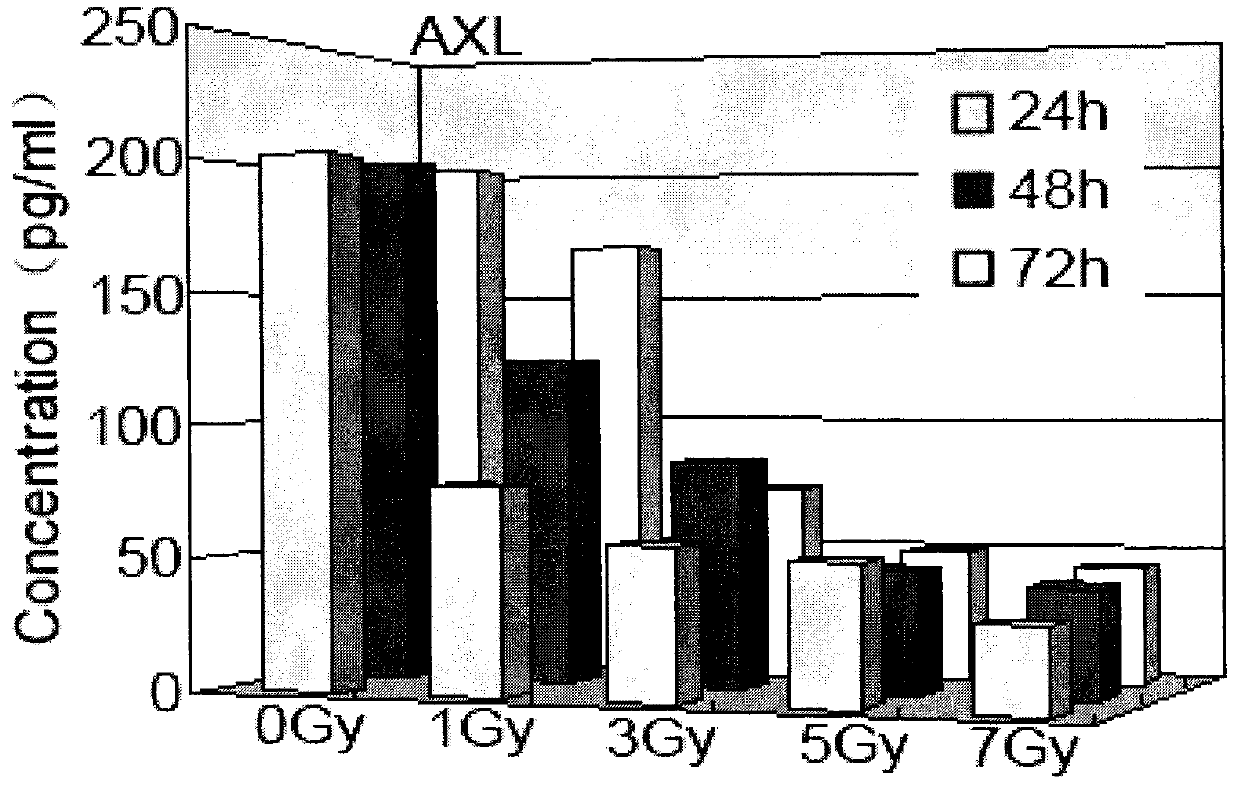Application of soluble receptor tyrosine kinase AXL serving as biological indicator for rapid estimation of ionizing radiation dose
A technology of tyrosine kinase and ionizing radiation, applied in the direction of biological testing, material inspection products, etc., can solve the problems of complexity and long detection cycle, and achieve the effect of less demand, short detection time and objective results
- Summary
- Abstract
- Description
- Claims
- Application Information
AI Technical Summary
Problems solved by technology
Method used
Image
Examples
Embodiment 1
[0025] Implementation Example 1: Establishment of Mouse Irradiation Model and Sample Collection
[0026] Experimental animals: male C57BL / 6 mice, 7 weeks old, weighing 19±1g, purchased from Shanghai Slack Experimental Animal Co., Ltd., animal quality certificate number: 2007000534826, experimental animal production license number SCXK (Shanghai) 2007- 0005.
[0027] Serum preparation: Mice were irradiated at 60 In the cobalt source room, 80 mice were randomly divided into four groups, 20 in each group: 1 group in the control group and 4 groups in the radiation group. The mice in the radiation group received 1Gy, 3Gy, 5Gy and 10Gy total body irradiation respectively at a dose rate of 0.78Gy / min. 24h, 48h, and 72h after irradiation, blood was collected from the mice through the eyeball. The whole blood was clotted at 37°C for 1h, centrifuged at 3000rpm×15min, and the supernatant serum was separated and distributed in centrifuge tubes at 100μl / tube. Aliquoted serum was frozen ...
Embodiment 2
[0028] Implementation example two: detection of sAXL content in mouse serum
[0029] (1) Detection of sAXL content in serum of non-irradiated mice
[0030] Testing materials and methods:
[0031] Cytokine antibody chip detection. The chip name is: Custom Mouse Array chip, customized by RayBiotech. The chip detection operation steps are as follows:
[0032] ① Place the chip bag at room temperature for 30 minutes, tear off the sealing film, mark the chip, and dry it for 2 hours on a clean bench;
[0033] ②Sample preparation: 60μl serum + 60μl diluent, mix well;
[0034] ③Preparation of standard substance: take 10000pg / ml standard solution (std1), three-fold dilution 6 times (std2~7), the lowest concentration is 13.7pg / ml (std7).
[0035] ④ Preparation of negative control: Take 120 μl of diluent (CNTRL)
[0036] ⑤ Chip blocking and sample incubation: add 100 μl blocking solution to each well, block at room temperature for 0.5 h, shake gently, add 100 μl negative control...
Embodiment 3
[0059] Implementation Example 3: Estimation of Irradiation Dose in Mice
[0060] According to the concentration of serum sAXL and the irradiation time, estimate the dose of the mice. The estimation method is shown in Table 5-7.
[0061] Table 5 Estimated dose of exposure to mice within 24 hours after irradiation
[0062]
[0063] Table 6 Estimated dose of exposure to mice 24 to 48 hours after irradiation
[0064]
[0065] Table 7 Estimated dose of exposure to mice 48-72 hours after irradiation
[0066]
PUM
 Login to View More
Login to View More Abstract
Description
Claims
Application Information
 Login to View More
Login to View More - R&D
- Intellectual Property
- Life Sciences
- Materials
- Tech Scout
- Unparalleled Data Quality
- Higher Quality Content
- 60% Fewer Hallucinations
Browse by: Latest US Patents, China's latest patents, Technical Efficacy Thesaurus, Application Domain, Technology Topic, Popular Technical Reports.
© 2025 PatSnap. All rights reserved.Legal|Privacy policy|Modern Slavery Act Transparency Statement|Sitemap|About US| Contact US: help@patsnap.com



